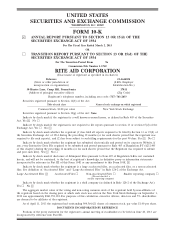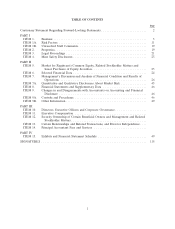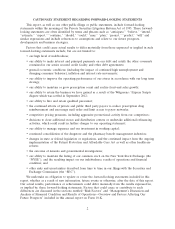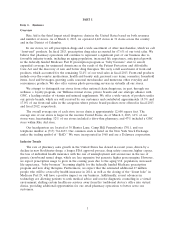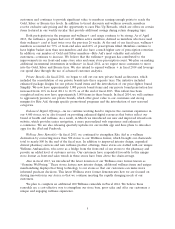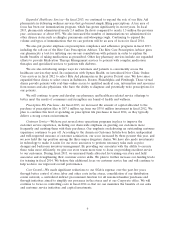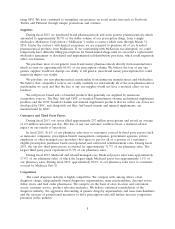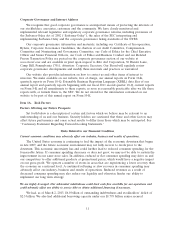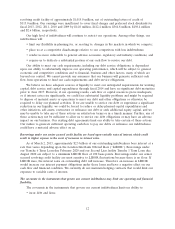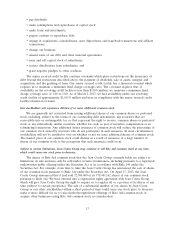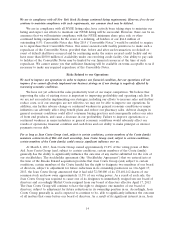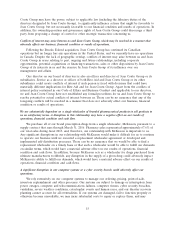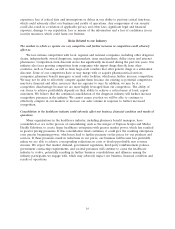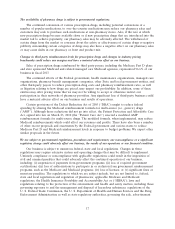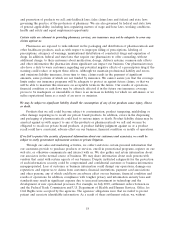Rite Aid 2013 Annual Report Download - page 9
Download and view the complete annual report
Please find page 9 of the 2013 Rite Aid annual report below. You can navigate through the pages in the report by either clicking on the pages listed below, or by using the keyword search tool below to find specific information within the annual report.using GPS. We have continued to strengthen our presence on social media sites such as Facebook,
Twitter and Pinterest through unique promotions and contests.
Suppliers
During fiscal 2013, we purchased brand pharmaceuticals and some generic pharmaceuticals, which
amounted to approximately 88.7% of the dollar volume of our prescription drugs, from a single
wholesaler, McKesson Corporation (‘‘McKesson’’), under a contract which runs through March 31,
2016. Under the contract, with limited exceptions, we are required to purchase all of our branded
pharmaceutical products from McKesson. If our relationship with McKesson was disrupted, we could
temporarily have difficulty filling prescriptions for brand-named drugs until we executed a replacement
wholesaler agreement or developed and implemented self-distribution processes, which could negatively
affect our business.
We purchase most of our generic (non-brand name) pharmaceuticals directly from manufacturers
which account for approximately 80.0% of our prescription volume. We believe the loss of any one
generic supplier would not disrupt our ability to fill generic (non-brand name) prescriptions but could
negatively impact our results.
We purchase our non-pharmaceutical merchandise from numerous manufacturers and wholesalers.
We believe that competitive sources are readily available for substantially all of the non-pharmaceutical
merchandise we carry and that the loss of any one supplier would not have a material effect on our
business.
We sell private brand and co-branded products that generally are supplied by numerous
competitive sources. The Rite Aid and GNC co-branded PharmAssure vitamin and mineral supplement
products and the GNC branded vitamin and mineral supplement products that we sell in our stores are
developed by GNC, and along with our Rite Aid brand vitamin and mineral supplements, are
manufactured by GNC.
Customers and Third Party Payors
During fiscal 2013, our stores filled approximately 297 million prescriptions and served an average
of 2.0 million customers per day. The loss of any one customer would not have a material adverse
impact on our results of operations.
In fiscal 2013, 96.6% of our pharmacy sales were to customers covered by third party payors (such
as insurance companies, prescription benefit management companies, government agencies, private
employers or other managed care providers) that agree to pay for all or a portion of a customer’s
eligible prescription purchases based on negotiated and contracted reimbursement rates. During fiscal
2013, the top five third party payors accounted for approximately 71.7% of our pharmacy sales. The
largest third party payor represented 35.3% of our pharmacy sales.
During fiscal 2013, Medicaid and related managed care Medicaid payors sales were approximately
17.4% of our pharmacy sales, of which the largest single Medicaid payor was approximately 1.1% of
our pharmacy sales. During fiscal 2013, approximately 30.0% of our pharmacy sales were to customers
covered by Medicare Part D.
Competition
The retail drugstore industry is highly competitive. We compete with, among others, retail
drugstore chains, independently owned drugstores, supermarkets, mass merchandisers, discount stores,
dollar stores and mail order pharmacies. We compete on the basis of store location and convenient
access, customer service, product selection and price. We believe continued consolidation of the
drugstore industry, the aggressive discounting of generic drugs by supermarkets and mass merchandisers
and the increase of promotional incentives to drive prescription sales will further increase competitive
pressures in the industry.
8

